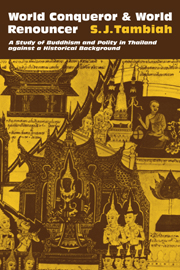 World Conqueror and World Renouncer
World Conqueror and World Renouncer Book contents
- Frontmatter
- Contents
- Acknowledgments
- PART ONE
- PART TWO
- 13 The Composition and Distribution of Religious Personnel: What the Figures Say
- 14 Monkhood as an Avenue of Social Mobility
- 15 Monastic Careers and Monastic Network
- 16 Patronage of the Sangha and the Legitimation of the Polity
- 17 Reformism and Ideological Transformation Based on Tradition
- 18 Missionary Monks (Thammathud) and National Development
- 19 The Politics of National Development and the Symbols of Legitimacy
- 20 Dialectical Tensions, Continuities, Transformations, and the Uses of the Past
- Bibliography
- Index
18 - Missionary Monks (Thammathud) and National Development
Published online by Cambridge University Press: 10 November 2010
- Frontmatter
- Contents
- Acknowledgments
- PART ONE
- PART TWO
- 13 The Composition and Distribution of Religious Personnel: What the Figures Say
- 14 Monkhood as an Avenue of Social Mobility
- 15 Monastic Careers and Monastic Network
- 16 Patronage of the Sangha and the Legitimation of the Polity
- 17 Reformism and Ideological Transformation Based on Tradition
- 18 Missionary Monks (Thammathud) and National Development
- 19 The Politics of National Development and the Symbols of Legitimacy
- 20 Dialectical Tensions, Continuities, Transformations, and the Uses of the Past
- Bibliography
- Index
Summary
Given the activistic ideological orientations discussed in the previous chapter it is not surprising that in recent years monks have become involved in various community development and missionizing programs – variously called thammathud, thammacarik, thammapatana, and so on. These programs relate to the hill tribes and to the politically sensitive and economically least developed border regions, especially in the northeast, north, and south. (The thammathud program also includes the sending of missions of monks to foreign countries – to Malaysia, Indonesia, to Europe and America – in order to propagate Buddhism there – but we are not concerned with that here.)
Once again the ideological legitimation for this thrust is alleged to be found in impeccable doctrinal texts. Many contemporary monks would refer one to the oft-quoted Buddha's admonition to the first group of monks he sent out to spread the teaching: “Go you forth, O Bhikkhus … to preach the divine life for the benefit and happiness of the world, including gods and men” (Mahavagga, Vinaya Pitaka). Another popular citation is: “The Dhamma and Vinaya of the Tathagata is present in the world for the happiness of the world including gods and men” (Catuhkanipata, Anguttara Nikaya).
Monks ambitious for their religion look back to the glorious age of Emperor Asoka, when Buddhism is believed to have been propagated to all regions of India and also overseas.
- Type
- Chapter
- Information
- World Conqueror and World RenouncerA Study of Buddhism and Polity in Thailand against a Historical Background, pp. 434 - 471Publisher: Cambridge University PressPrint publication year: 1976
- 1
- Cited by


